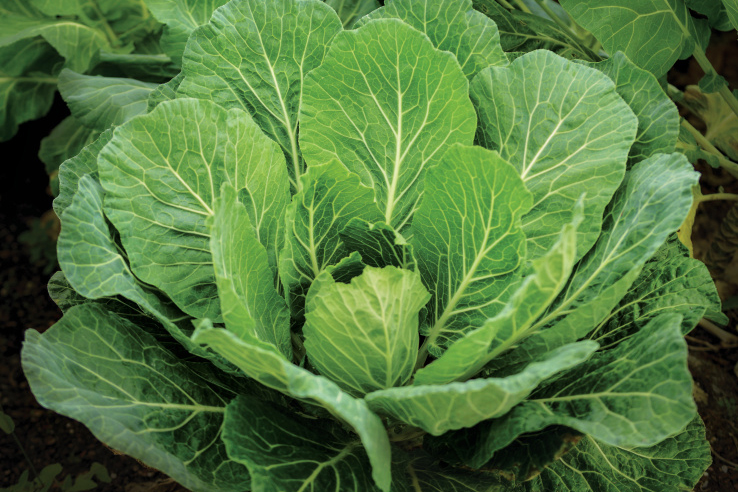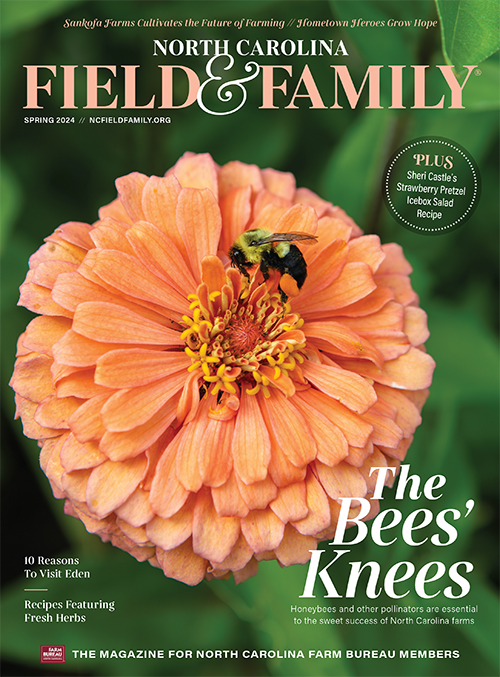North Carolina Collard Greens Are Making a Comeback
Commonly found on the table with any traditional Southern meal, North Carolina collard greens are appealing to a new generation.
Jodi Helmer |
Commonly found on the table with any traditional Southern meal, North Carolina collard greens are appealing to a new generation. Now known as a superfood like their cousin kale, collards have gained a reputation as a delicious, nutritious and locally loved vegetable throughout winter and beyond.
When Seven Sisters Farm sells collard greens at the Uptown Farmers Market in Charlotte, shoppers often share their childhood memories of eating collards.
“It’s an old Southern green that people remember their grandma cooking,” says Michael Fine, owner of the farm in Denton. “But the traditional crop remains popular.”
See more: Hail to the Collard Green
Collards are a member of the Brassica oleracea species, and the cool-season crop thrives in North Carolina. In fact, the state ranks as the third-leading collard producer in the nation behind neighbors South Carolina and Georgia.
“If you’re from North Carolina, you probably grew up eating collards in the fall or at Thanksgiving,” says Aaron Moore, agriculture Extension agent at the NC Cooperative Extension’s Union County Center. “But you can grow collards throughout a large part of the year. They’re a delicious vegetable to come out of the garden.”

Growing North Carolina Collard Greens
An adaptable crop, collard greens can be grown from seeds or transplants, planted in the spring and fall, and harvested as tender leaves or mature plants. The time to maturity ranges from 32 to 100 days depending on the variety, according to Moore.
Varieties popular in North Carolina include Flash, Morris Heading and Champion. Interest in heirloom varieties of collard greens has also gained momentum, with groups like the Heirloom Collard Project and Southern Exposure Seed Exchange working to revive older varieties such as Tabitha Dykes, Brickhouse Old and White Cabbage collards.
Jeff Bender of Bender Farms Inc. in Warren County grew collards for 10 years as part of a diversified vegetable farm. In the 2020 growing season, he planted a small plot of heirloom collard greens as a small experiment.
“We could actually tell the flavor difference in some of the varieties,” he notes.

Growers typically plant their collard crops in September when temperatures start to get cooler. Some collard fans believe that the leaves become sweeter after a frost and will wait until later in the season to pick or purchase the produce. A spring planting can be done in February while it’s still cold.
“These are cool-season plants,” Bender says. “They don’t tend to do very well if you put them out too early and they are exposed to excessive heat.”
Though the Benders recently moved away from produce to focus on other farming enterprises, many North Carolina farmers are turning to the specialty crop. In fact, the number of farms harvesting collards more than doubled from 202 in 2012 to 415 in 2017, according to the most recent data available from the USDA.
Collards are among 65 different vegetables grown at Seven Sisters Farm. On the 6-acre farm in Davidson County, Michael Fine and his wife, Janice, plant Georgia Southern collards in the fall and chop the entire plant at harvest so the greens can be boiled down for stews, curries and side dishes. In the spring, Top Bunch is their go-to variety because the new leaves can be picked and bundled for use in stir-fries and salads.
“It’s a versatile green,” Fine says.

Harvesting and Cooking
Like other greens, collards are harvested by hand. Some growers pick new leaves, which are more tender, have a milder flavor and taste delicious when eaten raw. Others let the leaves grow larger and harvest the entire plant. Larger leaves have a slightly bitter flavor, making them better suited for cooking.
“As collards have developed and more varieties have come out, people are becoming more aware of all of the ways you can cook with collards, and they’re becoming much more popular year round,” Moore says.
See more: Green Curry Collards Recipe by Vivian Howard
Although collards can be eaten at almost any time of the year, they frequently appear on tables during the holidays. Traditional recipes feature collards boiled with bacon, ham or other smoky ingredients. The liquid that remains after boiling collard greens is called pot likker, and you can use it to add flavor to soups and stews.
Collards can also be tossed into mac and cheese or cooked with garlic and onion to serve as a veggie side dish. Bender calls the greens “a nutrient powerhouse” because they are chock-full of vitamin A, vitamin C and calcium.

A New Year’s Tradition
Eating collard greens on New Year’s Day remains a longstanding tradition in the South. Many believe that since collards are the color of money, they will ensure a prosperous new year. The ritual also typically includes black-eyed peas, for good luck; tomatoes, symbolizing wealth; and golden cornbread for gold.
According to Fine, the crop also brings good luck to growers.
“Collards are a specialty crop that people love, and it’s an important market for small farms,” he says. “I always ask people to buy local. Collards grow so well in the state, so it makes sense to buy local.”
See more: A Collection of Collard Green Recipes
– Jodi Helmer



As noted in the article, I too have a grandmother tale. As a girl in a poorish household grandma would pick collards as well as mustards from the garden in South FL, wash and put on all four burners in the largest pots available with ham hocks! Boy could she make the house stink!
Where can I purchase the seeds? I have been searching for Yates seeds but will try these if I can get them
Ms. Muse, you may want to try Southern Exposure Seed Exchange as listed in the article. Here’s their website: https://www.southernexposure.com/search/?q=Collard.
Good luck.